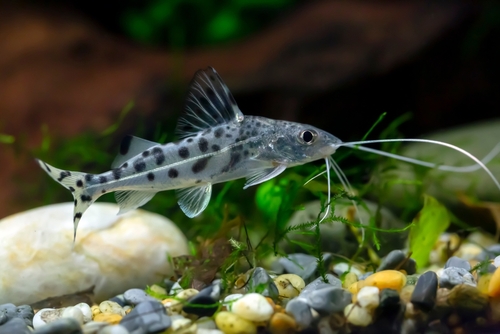Pictus catfish, also known as Pimelodus pictus, are a popular species of catfish that are native to South America.
These fish are known for their unique appearance, with their dark spots and striped pattern, and their active and playful behavior. One of the most important aspects of caring for Pictus catfish is understanding their dietary needs.
Pictus catfish are omnivorous and will eat a variety of foods in the wild, including insects, crustaceans, and plant matter. In captivity, it is important to provide a balanced diet that includes both protein and vegetables.
Feeding them a varied diet will help ensure that they receive all of the nutrients they need to stay healthy and thrive in their environment.
Contents
Key Takeaways on What Do Pictus Catfish Eat?
- Pictus catfish are a South American species known for their unique appearance and active behavior.
- These fish are omnivorous and require a balanced diet that includes both protein and vegetables.
- Providing a varied diet will help ensure that Pictus catfish receive all of the nutrients they need to stay healthy and thrive in their environment.
Check out these other related posts:
Overview of Pictus Catfish
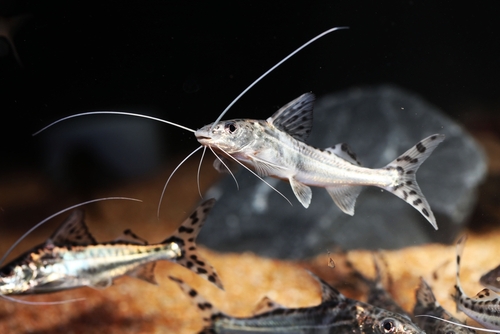
Pictus catfish, also known as Pimelodus pictus, are a popular species of catfish that are commonly kept in home aquariums. They are native to South America, specifically the Amazon and Orinoco River basins.
These fish are known for their unique appearance, with their dark body covered in white spots and their long barbels.
Pictus catfish are a part of the Pimelodidae family, which includes over 100 species of catfish. They are also sometimes referred to as angel cat or angelicus catfish. These fish were first described by Franz Steindachner in 1876.
In the wild, pictus catfish are omnivores and will eat a variety of foods including insects, crustaceans, and plant matter. In the aquarium, they can be fed a diet of pellets, flakes, frozen or live foods such as bloodworms, brine shrimp, and krill.
Pictus catfish are generally peaceful and can be kept with other non-aggressive fish. They are active swimmers and prefer a well-oxygenated aquarium with plenty of hiding places such as caves or driftwood.
They can grow up to 5 inches in length and require a minimum tank size of 30 gallons.
Lifespan
In captivity with proper care, pictus catfish typically live 5-10 years. Some have been reported to reach 12 years. Their lifespan is directly related to water quality and diet.
Natural Habitat
Pictus catfish are native to the muddy waters of the Amazon River basin in South America. They can be found in a variety of habitats, including slow-moving rivers, streams, and flooded forests.
In the wild, pictus catfish are opportunistic feeders and will eat a wide variety of foods. Their diet consists mainly of small fish, crustaceans, and insects. They are also known to eat plant matter, such as algae and aquatic vegetation.
The Amazon River basin is home to an incredibly diverse array of flora and fauna, and the pictus catfish is no exception. They have adapted to their natural habitat and are able to thrive in the muddy waters of the Amazon.
Aquascaping Recommendations
To mimic Pictus catfish’s natural environment, a planted aquarium is ideal. A sandy or fine gravel substrate 2-3 inches deep allows them to sift and forage.
Driftwood, rocks, cave formations, and aquatic plants like Anubias and Java Fern provide necessary hiding spots and enrich the tank. Floating plants are also recommended to diffuse light.
Aim for a natural-looking setup with plenty of open swimming space and a darker substrate to make the fish feel secure.
Physical Characteristics
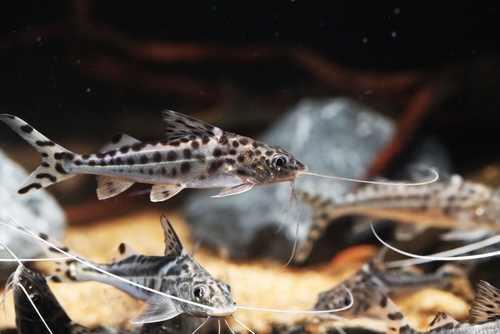
Pictus catfish are a small species of catfish that typically grow to be around 5 inches in length. They are known for their distinctive appearance, which includes black spots all over their body and a forked tail.
One of the most notable physical characteristics of the pictus catfish is their barbels. These are sensory organs that are located around the mouth and help the fish to locate food in the dark or murky water.
The pictus catfish has four pairs of barbels, which are relatively long and slender compared to other catfish species.
The dorsal fin of the pictus catfish is located on the back of the fish and is relatively tall and pointed. It is used for stability and steering, and can also be used to help the fish swim more quickly.
The pectoral fins are located on the sides of the fish and are used for maneuvering and braking.
In terms of appearance, the pictus catfish is a very attractive fish. They have a silver-gray body with black spots all over, which gives them a unique and eye-catching look. Their forked tail is also quite distinctive, and helps to distinguish them from other catfish species.
Behavior and Temperament
Pictus catfish are known for their peaceful and non-aggressive temperament. They are often kept in community aquariums with other peaceful fish species.
These catfish are shoaling species, which means they prefer to be kept in groups of six or more. They are bottom dwellers and spend most of their time hiding in caves, under rocks, or in plants.
Pictus catfish are nocturnal scavengers and are most active at night. They have a keen sense of smell and are able to locate food by detecting chemical signals in the water. In the wild, they feed on small invertebrates, crustaceans, and insects.
In captivity, they will readily accept a variety of foods, including pellets, flakes, frozen or live foods such as bloodworms, brine shrimp, and daphnia.
It is important to note that pictus catfish are sensitive to water quality and require a well-maintained aquarium with good filtration. They are also known to be jumpers, so it is recommended to have a tightly fitting lid on the aquarium to prevent them from escaping.
Pictus Catfish Care Guide
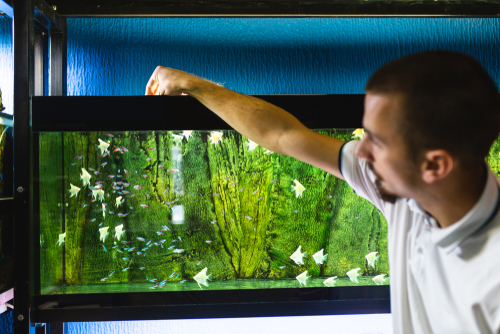
Pictus catfish, also known as Pimelodus pictus, are a popular species of catfish among aquarium enthusiasts. These fish are native to South America and are known for their striking appearance and active behavior.
To ensure that your Pictus catfish thrive in your aquarium, it is important to provide them with proper care and a suitable environment.
Aquarium Setup and Substrate
When it comes to setting up an aquarium for Pictus catfish, it is important to keep in mind that these fish are active swimmers and prefer a spacious tank.
A minimum tank size of 30 gallons is recommended for a single Pictus catfish, with an additional 10 gallons for each additional fish.
Pictus catfish prefer a sandy substrate in their aquarium, which can help mimic their natural habitat in the wild. A substrate depth of 2-3 inches is recommended to allow for burrowing and foraging behavior.
Filtration and Water Parameters
A suitable filtration system is essential for the health and well-being of Pictus catfish. A canister filter or a hang-on-back filter is recommended for these fish, as they produce a lot of waste.
It is important to keep the water clean and well-oxygenated, as Pictus catfish are sensitive to poor water quality.
Pictus catfish prefer a slightly acidic to neutral pH range between 6.5 and 7.5, and a water temperature between 75°F and 82°F. Regular water changes of 20-30% every 2-3 weeks are recommended to maintain good water quality.
Decor and Plants
Pictus catfish enjoy having hiding places in their aquarium, such as caves and driftwood. Live plants such as hornwort and java moss can also be added to the aquarium, which not only provide hiding places but also help to improve water quality by absorbing nitrates.
Conservation Status
Pictus catfish are currently not threatened in their native habitat. They are classified as Least Concern by the IUCN Red List. Responsible collection practices help protect wild populations. Their popularity in the aquarium trade has led to captive breeding programs.
Community Tanks
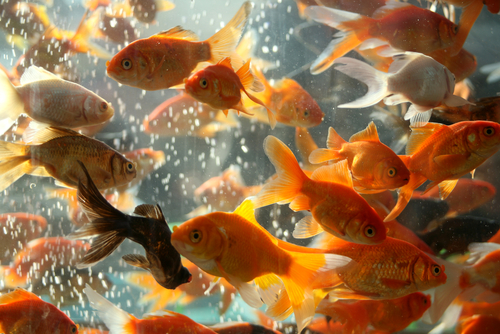
Pictus catfish are social fish and can be kept in a community tank with other non-aggressive species. However, it is important to keep in mind that Pictus catfish can grow up to 5 inches in length, so it is important to choose tank mates that are of similar size and temperament.
Tank Requirements
Pictus catfish are active fish that require a large tank to thrive. The minimum tank size for a single Pictus catfish is 30 gallons.
However, it is recommended to keep them in groups of at least three, so a larger tank is necessary. A 55-gallon tank is a good starting point for a small group of Pictus catfish.
It is important to provide a dimly lit environment for Pictus catfish. They are nocturnal fish that prefer to hide during the day. A well-planted tank with plenty of hiding places, such as caves and driftwood, will make them feel more secure.
A substrate of sand or small gravel is also recommended, as Pictus catfish like to sift through the substrate in search of food.
In addition to a good hiding place, Pictus catfish require a strong current in the tank. A powerhead or strong filter will provide the necessary water movement. However, it is important to ensure that the current is not too strong, as this can stress the fish.
Feeding and Diet

Pictus catfish are omnivorous and require a balanced diet to thrive. They will eat a variety of foods, including live and frozen foods, sinking pellets, and plant matter.
Bloodworms, brine shrimp, and insects are all excellent sources of protein that can be fed to pictus catfish. They also enjoy algae and other plant matter, which can be provided in the form of sinking pellets or fresh vegetables.
To ensure a healthy diet, it is recommended to feed pictus catfish a combination of live and frozen foods, along with sinking pellets. A varied diet will help prevent nutritional deficiencies and promote overall health.
It is important to note that pictus catfish are bottom-dwellers, so their food should sink to the bottom of the tank. Sinking pellets are a good option for this reason.
Proper Feeding
Overfeeding can degrade water quality. Offer pictus catfish food once or twice a day and watch to see if it is fully consumed within 2 minutes. It is best to vary pictus catfish diet between live, frozen, freeze-dried, and prepared foods to provide balanced nutrition. Use sinking pellets or wafers as their mainstay.
Avoid flake foods as pictus catfish are bottom feeders.
Tank Mates
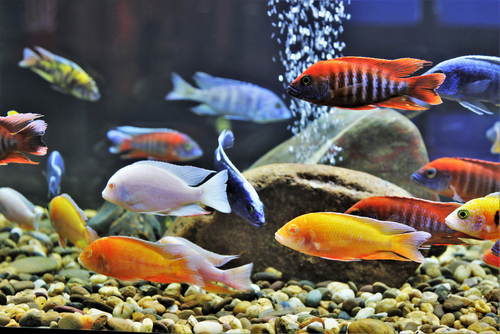
Pictus catfish are known for being active and social fish, making them a great addition to a community tank. However, it is important to choose tank mates carefully to ensure everyone gets along and thrives.
When choosing tank mates for pictus catfish, it is important to consider their size and activity level. They are relatively peaceful fish but can be aggressive towards smaller, slower fish. Therefore, it is recommended to avoid keeping them with very small fish, such as neon tetras.
Danios are a good tank mate for pictus catfish because they are similar in size and activity level. They are also peaceful fish that can coexist with pictus catfish without any issues.
Snails are another good option for tank mates. They are slow-moving and will not bother the pictus catfish. In fact, they can help keep the tank clean by eating algae and other debris.
It is important to note that pictus catfish are predatory fish and will eat smaller fish if given the opportunity. Therefore, it is recommended to avoid keeping them with very small fish, such as neon tetras.
Breeding Pictus Catfish
Pictus catfish are known to breed in captivity, and it can be an exciting experience for fish keepers. However, breeding pictus catfish requires some preparation and knowledge.
Sexual Maturity
Pictus catfish reach sexual maturity at around 8-10 months of age. It is essential to ensure that the fish are healthy and well-fed before breeding. A well-balanced diet that includes live or frozen foods can help prepare the fish for breeding.
Breeding
Breeding pictus catfish is triggered by changes in water conditions, such as a drop in temperature or a change in water chemistry. It is recommended to simulate these changes by performing partial water changes and lowering the temperature by a few degrees.
During breeding, the male will chase the female around the tank, and they will engage in a courtship dance. The female will lay her eggs on a flat surface, such as a rock or a breeding cone. The male will then fertilize the eggs.
After spawning, the eggs will hatch in 2-3 days, and the fry will become free-swimming after another 4-5 days. It is essential to remove the adult fish from the breeding tank to prevent them from eating the fry.
Health and Diseases
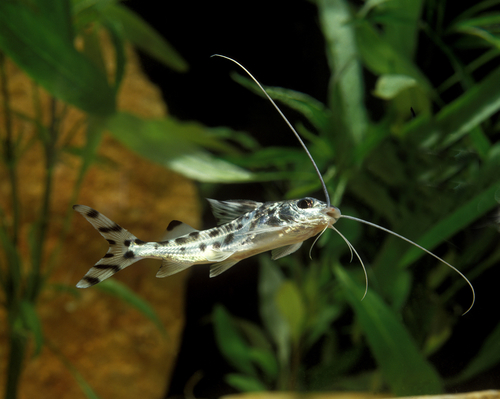
Pictus catfish are generally hardy and resistant to many common aquarium diseases. However, they can still be affected by various health issues that can negatively impact their lifespan.
One common disease that affects pictus catfish is ich, which is caused by a parasite that attaches to the fish’s body and fins. Symptoms of ich include white spots on the fish’s body and fins, and the fish may also become lethargic and lose its appetite.
Ich can be treated with medication, but it is important to catch it early to prevent it from spreading to other fish in the aquarium.
Another potential health issue for pictus catfish is bacterial infections. These can be caused by poor water quality, overcrowding, or injuries to the fish.
Symptoms of bacterial infections include open sores, redness, and swelling. Treatment for bacterial infections typically involves antibiotics, but again, prevention is key.
To promote the health of pictus catfish, it is important to maintain a clean and well-filtered aquarium. Regular water changes and monitoring of water parameters can help prevent the buildup of harmful bacteria and other pathogens.
Additionally, providing a varied diet that includes live or frozen foods like daphnia can help boost the fish’s immune system and overall health.
Signs of Stress and Illness
Look for these indications of stress or sickness in pictus catfish:
1. Loss of Appetite
A healthy pictus catfish readily consumes offered foods. When these voracious eaters suddenly lose interest in meals, an underlying health problem is likely brewing. Loss of appetite often precedes other symptoms.
2. Lethargy
Pictus catfish are normally energetic fish darting about the tank. Lethargy is a clear red flag. Affected fish become listless, inactive and spend more time resting on the bottom. This depressive state signals illness or that conditions are amiss.
3. Hiding
While pictus catfish enjoy having hiding spots, increased reclusiveness can mean sickness. An unwell fish will isolate itself more than usual. It may wedge into a corner, under plants or other cover. This hiding behavior demonstrates its vulnerability.
4. Clamped Fins
Healthy pictus catfish fully spread their fins while swimming. Clamped fins are held tightly against the body, indicating discomfort or distress. The fins also may appear frayed or deteriorated.
5. Labored Breathing
Watch for signs of respiratory distress like rapid gill movement. The gills should open and close smoothly, not struggle for oxygen. Fast breathing could reflect poor water quality or respiratory infection.
Conclusion
Pictus catfish are omnivorous and can eat a variety of foods in the wild and in captivity. Their diet should consist of a mix of protein-rich foods and plant matter to ensure they receive all the necessary nutrients.
Live or frozen foods such as bloodworms, brine shrimp, and daphnia are excellent sources of protein for Pictus catfish. They also enjoy eating vegetables such as zucchini, cucumber, and spinach.
Pellets and flakes are also suitable food sources for Pictus catfish, but they should not be the only food source.
It is important to avoid overfeeding Pictus catfish as they have a tendency to overeat. Overfeeding can lead to health issues such as obesity and poor water quality. A good rule of thumb is to feed them small amounts of food twice a day.
Frequently Asked Questions
What are some suitable foods for Pictus Catfish?
Pictus Catfish are omnivores and will eat a variety of foods. They enjoy live or frozen foods such as bloodworms, brine shrimp, and daphnia. They also eat pellets and flakes, but it is important to provide a varied diet to ensure they receive all necessary nutrients.
Can Pictus Catfish coexist with other fish in an aquarium?
Pictus Catfish are generally peaceful and can coexist with other fish in an aquarium. However, they are active swimmers and may bother slower or more timid fish. It is important to provide ample hiding places and space for all fish to ensure they can coexist peacefully.
What are some appropriate tank mates for Pictus Catfish?
Pictus Catfish can coexist with a variety of fish, but it is important to choose appropriate tank mates. They do well with other active fish such as tetras, barbs, and loaches. Avoid keeping them with aggressive or territorial fish.
Are Pictus Catfish known to eat snails?
Pictus Catfish may eat snails, but it is not a major part of their diet. They are more likely to eat snails if they are small or injured.
Do Pictus Catfish eat small fish?
Pictus Catfish may eat small fish, but it is not their primary food source. They are more likely to eat small fish if they are sick, injured, or dead.
What is the ideal diet for Pictus Catfish?
The ideal diet for Pictus Catfish includes a variety of live or frozen foods such as bloodworms, brine shrimp, and daphnia. They also benefit from a balanced diet of pellets and flakes. It is important to provide a varied diet to ensure they receive all necessary nutrients.
What do catfish eat exactly?
Catfish are omnivorous, meaning they eat both plant and animal matter. Common foods for catfish include insects, crustaceans, mollusks, plankton, algae, and plant debris. Many catfish are also scavengers and will feed on dead or decaying organisms.
Do pictus catfish eat algae?
Yes, pictus catfish do eat algae. In the wild, pictus catfish are omnivores and will eat both plant and animal matter. Algae often form a part of their natural diet.
What to feed pictus catfish?
Feed them quality omnivore sinking pellet or flake as their staple food. You can also supplement with frozen or live foods like bloodworms, brine shrimp, and daphnia.

Ian Sterling, founder of Fishlab.com, began his aquarium journey over 30 years ago, driven by a deep fascination for fish and their diverse personalities. His website, Fishlab.com, is dedicated to making fishkeeping accessible and enjoyable, offering beginner-friendly guidance, expert insights, and a community for aquarists to connect and share experiences.


